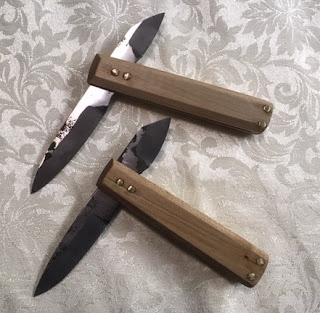I've actually been wanting to make this knife for more than 20 years, but never did until now. I discovered a book about that long ago in the local university library with the lovely title of Viking Artefacts. Yes, that's the correct spelling. There are only a couple of knives in the whole book, but one of them is this one:
(Please note, this particular photo is taken from warehamforge.com, not a scan by me.)
I wanted to make this because it seemed such a clever and useful knife. I do make some changes to the design, as you'll see if you read on. Still, the basic concept of a friction folder with two blades remains. At any time, one of the two blades will be out. The other will be in the handle. At the time I discovered this, I hadn't heard of anyone else making one. However, it seems to be a common knife for historical bladesmiths to make now, so I'm hardly the only one to create another one and very certainly not the first to put it online.
Since much of the early work is the same as any other knife, I'll skip right to the part where it starts getting a bit different.
This is what the blades look like:
As is my normal practice, I work on two blades at a time. Two irons in the fire is a saying that comes from blacksmithing. One can heat while the other is being hammered. This saves time and fuel, since burning fuel in the forge is wasted if there's no steel or iron being heated by it. The picture above shows one blade just out of heat treating and the other right after being finish-ground.
Both blades finish ground. As is my usual aesthetic, I like to leave some evidence of the hand forging in the form of texture on the blades. There needs to be some good flat steel where the pivot happens, but I think I struck a good balance here with the visible texture and the flat-ground steel.
A trial fit-up. I chose maple instead of bone for the handle scales because I like maple so much. Plus, I have maple in the workshop and I don't have bone scales I can use at this time. All the bone I have is too small for these handles. I'm not trying to make a strict reproduction, just to make a knife that works from that same inspiration. The spacer at the butt end is a modern thing. I also put the butt pins in a different configuration from the original. This is what worked for me and I freely admit that it is a modern knife, not an ancient one.
Once I'm confident that the pins are in the right places, the blade at the pivot area is adjusted right, and everything is flat, I can put another scale on top and pein the pins down to lock it all together.
These have the small blades out.
Now, they are shown half-switched.
Long blades out.
These are both a little stiff. Friction folders depend on a tight fit to stay in position. After a while, they do loosen up a little (just normal wear will compress the wood slightly) and if they eventually get at all floppy, the owner will have to tap the pivot pin with a hammer a couple of times. Still, friction folders have been in use for at least 2000 years (I've seen pictures of one from Ancient Rome, so the idea of a folding knife is not new). Something doesn't last two millennia if it doesn't work.
Carrying a knife like this means you really need a sheath. I did toy with the idea of trying to make a period-appropriate sheath, but these are really modern knives with ancient inspiration, not real reproductions. I made my usual belt sheaths. I really like the Oxblood dye for a sheath. It looks somehow nicer than a black or brown sheath to me.
One of the sheaths is left-handed because it is a gift for a lefty. This is another exchange on Primitive Archer. The right-handed sheath is for me. I've wanted one of these for so many years, it almost hurts to give either of them away. But I picked the nicer of the two (smoother folding action, slightly nicer grind detail) and that's going to my recipient when I go to the post office later today.
If you want to make one of these, I suggest you give it a try. They are fun and a really cool novelty. I suggest taking your time with the pivot area. I actually have messed that up several times (previous efforts at making the same knife), so I know that it is possible to go just a tiny bit too far and ruin the whole piece. But if you are more patient (like I was with these two), it isn't really all that sophisticated, so it won't be too daunting. I'd love to see other folks make these and share pictures of them!






















































